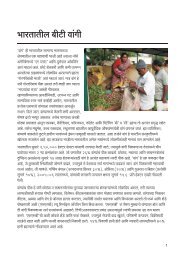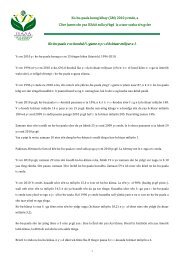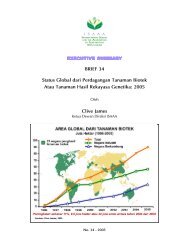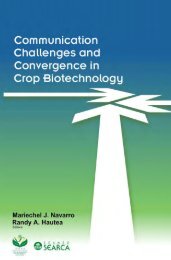Information Tug-of-War: Saga of Biotech Papaya 7 Agricultural - isaaa
Information Tug-of-War: Saga of Biotech Papaya 7 Agricultural - isaaa
Information Tug-of-War: Saga of Biotech Papaya 7 Agricultural - isaaa
Create successful ePaper yourself
Turn your PDF publications into a flip-book with our unique Google optimized e-Paper software.
<strong>Information</strong> <strong>Tug</strong>-<strong>of</strong>-<strong>War</strong>: <strong>Saga</strong> <strong>of</strong> <strong>Biotech</strong> <strong>Papaya</strong><br />
The Kingdom <strong>of</strong> Thailand is an<br />
ThAIlAND<br />
independent country in Southeast Asia.<br />
It is bordered on the north by Burma and<br />
Laos, to the east by Laos and Cambodia, to the<br />
south by the Gulf <strong>of</strong> Thailand and Malaysia,<br />
and to the west by the Andaman Sea and the<br />
southern part <strong>of</strong> Burma. It has a land area <strong>of</strong><br />
513,115 square kilometers and has a population<br />
<strong>of</strong> 68 million.<br />
Thailand is ranked among the top 10 food-producing countries worldwide.<br />
Roughly 40% <strong>of</strong> Thailand’s labor force are employed in agriculture. Rice is the<br />
country’s most important crop making the country the largest exporter in the<br />
world rice market. It is also the world’s largest rubber producer, second largest<br />
sugar exporter, and Asia’s top exporter <strong>of</strong> chicken meat, shrimp, and several<br />
other commodities. It produces significant amounts <strong>of</strong> fish and fishery products,<br />
tapioca, rubber, corn, and sugar (NSTDA, 2010). Exports <strong>of</strong> processed foods<br />
such as canned tuna, canned pineapple, and frozen shrimps are also significant.<br />
Agriculture contributes 8.2% <strong>of</strong> Gross Domestic Product (GDP).<br />
system placing emphasis on the safety <strong>of</strong> the process and final product.<br />
Modern technology, such as plant biotechnology and genetic engineering,<br />
is part <strong>of</strong> the arsenal to improve agricultural production not just to produce<br />
more food and feed, but also to develop value-added products in the areas <strong>of</strong><br />
nutraceuticals and medicinal products (Sriwatanapongse et al., 2007).<br />
<strong>Biotech</strong>nology Research and Development<br />
The National Genetic Engineering and <strong>Biotech</strong>nology Center (BIOTEC) under<br />
the National Science and Technology Development Agency (NSTDA), Ministry<br />
<strong>of</strong> Science and Technology was established in 1983. More than 200 students<br />
were sent to study abroad on biotechnology-related fields. Likewise, state-<strong>of</strong>the-art<br />
laboratories and work facilities were developed over time. By 2003,<br />
an additional 638 researchers completed degrees that enabled them to join<br />
the biotechnology workforce. To support research and development (R&D) in<br />
the field, the Plant Genetic and Engineering Unit (PGEU) was set up in 1995<br />
at the Kasetsart University (KU), Kampaengsaen campus in Nakhom Pathom<br />
province, about 80 kilometers away from Bangkok. Kasetsart, which literally<br />
means “agricultural sciences” has traditionally been rooted in agriculture but<br />
now <strong>of</strong>fers a variety <strong>of</strong> disciplines.<br />
Chapter 7 157<br />
CouNTRy PR<strong>of</strong>Ile








